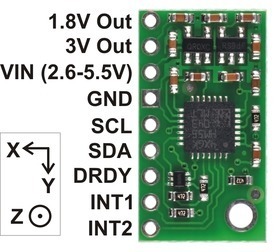Hello all,
This is my first post… usually I just search the forums, but I haven’t had any luck with searching for someone with this issue. In summary, I recently ported a project I’m working on from an Arduino with a LSM303DLM daughter board to a custom PCB running an ATMEGA644PA and an LSM303DLHC. The problem I am having is the final heading result is now off by 90 degrees (when the x-axis is pointing north, the heading is telling me I’m facing east).
Has anybody seen anything similar to this issue?
A couple of notes:
- I am aware of the new accelerometer address, and can successfully communicate with it via I2C.
- I have the high resolution bit enabled (but I have also tried it without this enabled).
- I downloaded the LSM303DLHC arduino library, and took note of the differences in the code vs. the LSM303DLM library. I believe I’ve updated my code accordingly.
- To the best of my knowledge, I’ve calibrated the compass correctly (the same as I did with the LSM303DLM, which worked fine).
Here are the relevant snippets of code:
static void smrt_io_compass_init()
{
TWSR = 0; // clear bit-rate prescale bits
TWBR = 17; // produces an SCL frequency of 400 kHz with a 20 MHz CPU clock speed
//enable accelerometer
i2c_start();
i2c_write_byte(ACC_ADDRESS); // write acc
i2c_write_byte(0x20); // CTRL_REG1_A
i2c_write_byte(0x77); // normal power mode, 400 Hz data rate, all axes enabled
i2c_start();
i2c_write_byte(ACC_ADDRESS);
i2c_write_byte(0x23); // CTRL_REG4_A
i2c_write_byte(0x8); // enable high resolution mode
i2c_stop();
//enable magnetometer
i2c_start();
i2c_write_byte(MAG_ADDRESS); // write mag
i2c_write_byte(0x02); // MR_REG_M
i2c_write_byte(0x00); // continuous conversion mode
i2c_stop();
}
void smrt_io_read_data(vector *a, vector *m)
{
smrt_io_read_data_raw(a, m);
// shift and scale
m->x = (m->x - m_min.x) / (m_max.x - m_min.x) * 2 - 1.0;
m->y = (m->y - m_min.y) / (m_max.y - m_min.y) * 2 - 1.0;
m->z = (m->z - m_min.z) / (m_max.z - m_min.z) * 2 - 1.0;
}
static void smrt_io_read_data_raw(vector *a, vector *m)
{
// read accelerometer values
i2c_start();
i2c_write_byte(ACC_ADDRESS); // write acc
i2c_write_byte(0xa8); // OUT_X_L_A, MSB set to enable auto-increment
i2c_start(); // repeated start
i2c_write_byte(ACC_ADDRESS+1); // read acc
unsigned char axl = i2c_read_byte();
unsigned char axh = i2c_read_byte();
unsigned char ayl = i2c_read_byte();
unsigned char ayh = i2c_read_byte();
unsigned char azl = i2c_read_byte();
unsigned char azh = i2c_read_last_byte();
i2c_stop();
// read magnetometer values
i2c_start();
i2c_write_byte(MAG_ADDRESS); // write mag
i2c_write_byte(0x03); // OUTXH_M
i2c_start(); // repeated start
i2c_write_byte(MAG_ADDRESS + 1); // read mag
unsigned char mxh = i2c_read_byte();
unsigned char mxl = i2c_read_byte();
// for the DLM and DLHC, the register address for Z comes before Y
unsigned char mzh = i2c_read_byte();
unsigned char mzl = i2c_read_byte();
unsigned char myh = i2c_read_byte();
unsigned char myl = i2c_read_last_byte();
i2c_stop();
// combine high and low bytes, then shift right to discard lowest 4 bits (which are meaningless)
// GCC performs an arithmetic right shift for signed negative numbers, but this code will not work
// if you port it to a compiler that does a logical right shift instead.
a->x = ((int16_t)(axh << 8 | axl)) >> 4;
a->y = ((int16_t)(ayh << 8 | ayl)) >> 4;
a->z = ((int16_t)(azh << 8 | azl)) >> 4;
m->x = mxh << 8 | mxl;
m->y = myh << 8 | myl;
m->z = mzh << 8 | mzl;
}
// Returns a heading (in degrees) given an acceleration vector a due to gravity, a magnetic vector m, and a facing vector p.
int smrt_io_get_heading(const vector *a, const vector *m, const vector *p)
{
vector E;
vector N;
vector_normalize(a);
// cross magnetic vector (magnetic north + inclination) with "down" (acceleration vector) to produce "east"
vector_cross(m, a, &E);
vector_normalize(&E);
// cross "down" with "east" to produce "north" (parallel to the ground)
vector_cross(a, &E, &N);
// compute heading
int heading = round(atan2(vector_dot(&E, p), vector_dot(&N, p)) * 180 / M_PI);
if (heading < 0)
heading += 360;
return heading;
}
